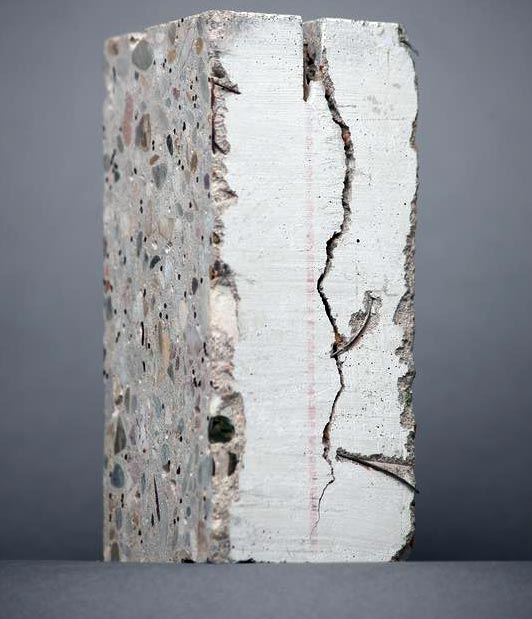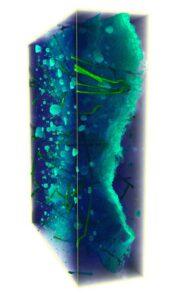CT analysis of concrete beams

Concrete sample with crack.
© Fraunhofer ITWM
Concrete’s properties as a material have made it an essential part of today’s construction methods. Alongside its many advantages, however, this universal favorite has its share of drawbacks – the most prominent being that its heterogeneous nature makes it difficult to dimension components and structures on the basis of simulations. Cracks induced by bending tests have provided some insights into component behavior. Now, researchers at the Fraunhofer ITWM are developing analysis software designed for computed tomography, with the aim of making it possible to see even the tiniest structural changes in reinforced concrete components.
Computed tomography gives us a glimpse into inner worlds. It has become an essential tool in medical applications, used to perform routine investigations in the human body. However, it also lends itself well to X-raying composite materials such as reinforced concrete and provides a non-destructive method of examining them. So what happens inside a concrete component when it is exposed to mechanical strain? Where do cracks occur? How are they created? And how do they grow as they are exposed to more and more strain? These are the questions that the researchers at Fraunhofer ITWM are seeking to answer.

© Fraunhofer ITWM
In the BMBF-funded DAnoBi project on detecting anomalies in large-scale spatial image data, they are collaborating with working groups at the Technical University of Kaiserslautern, Ulm University and the University of Magdeburg with the aim of using robust, automation-friendly methods of finding crack structures in concrete on the basis of computed tomography data, fully segmenting these structures and recording them. “Even in noisy CT data taken from small concrete samples, we have been able to not only detect cracks measuring mere micrometers, but also identify the voxels (data points on a three-dimensional grid) associated with them. The cracks must not be any wider than one voxel, so we can find cracks measuring 100 µm in a concrete block with an edge length of 15 cm,” says Dr. Katja Schladitz, a scientist at Fraunhofer ITWM. To achieve this, Schladitz and her team have combined machine learning methods, structure modeling and imaging, plus statistical methods for detecting cracks. “From the thickness and shape of the cracks, we can find out more about the relationship between post-cracking behavior and microstructures. Until now, however, we have only used the institute’s own CT equipment to observe things before or after applying strain, not during the process,” says Schladitz, who specializes in mathematics.
The world’s only CT system for the construction industry
The research is facing a problem in that micro-CT technology of the kind used at Fraunhofer ITWM is only able to X-ray concrete samples measuring a few centimeters in edge length and diameter. There is no way of performing mechanical strain tests on concrete samples that are several meters long. In the future, however, this will become a possibility thanks to the Department of Civil Engineering at the Technical University of Kaisers-lautern. A CT system that is unique in the world is currently being built there and will be operational in the summer of 2023. It works with significantly stronger X-rays – measuring some nine megaelectronvolts – than the kind emitted by medical X-ray equipment, making it possible to screen reinforced concrete components with a diameter of 30 centimeters and a length of six meters. One of the first and most important applications for the extensive system, named Gulliver, is 3D imaging of the way in which cracks develop in large concrete beams during a four-point bending test. The three-dimensional X-ray images captured during these processes will reveal significant new insights that can be used in research, and will help scientists gain a better understanding of the complex composite material that is concrete. In the process, Gulliver will generate between 120 gigabytes and two terabytes of image data per experiment. The aim of the research is to perform 3D imaging and analysis of structural changes caused by bending strain while a bending test is still going on.
Fraunhofer ITWM develops analysis software for Gulliver
“We are optimizing the storage management and image evaluation used in our extensive 3D image processing and analysis software so that the large quantities of data produced using this technology can be handled efficiently. The complex algorithms need to enable short response times during image processing,” explains Dr. Katja Schladitz. Identifying tiny structures within these large quantities of data is set to be a challenge – one that the software is responding to with extensive analysis methods for localized porosity, thickness and orientation analyses, for example.
The plan is to combine the expertise of structural engineers with 3D analysis techniques in order to select the best possible complex algorithms, set parameters for them, pro-duce accurate evaluations of interim results and correct errors as early as possible. An AI assistant is being developed to help achieve this: It will learn the expected work process and data flow, plus the expected interim results and typical error patterns, and will be trained using aspects such as CT measuring parameters and sample properties including dimensions and material mixtures in order to evaluate image data quality. This will give structural engineers a better foundation for performing calculations – relating to the load-bearing behavior of concrete, for example – which in turn will allow them to cut down on the amount of material used and adjust the content of the required reinforcing steel or fibers exactly as needed.
Harnessing quantum computing’s potential for image processing
In the future, it is hoped that quantum computing will accelerate the process of evaluating CT data – in applications beyond this one. By making clever use of the special properties inherent in qubits, it will be possible to represent extremely large-scale image data (of the kind generated by the Gulliver system) with just a few qubits: for example, 1,024 × 1,024 pixels with 21 qubits Replacing the filter and analysis algorithms that have been the standard so far with quantum image processing algorithms would make it possible to process these huge quantities of data more efficiently. In theory, it may also be possible to reduce both memory and computing requirements exponentially.
Practically speaking, encoding images and executing algorithms involves a large number of individual quantum operations, so the results of simple image processing steps performed on small images nowadays are often noisy to the point of unrecognizable. Because of this, noise models and algorithms that require as few basic operations as possible are currently being researched by Fraunhofer ITWM and other Fraunhofer institutes, as they are in the field of quantum computing generally.
Weitere Informationen:
https://www.fraunhofer.de/en/press/research-news/2022/march-2022/ct-analysis-of-…
Media Contact
All latest news from the category: Information Technology
Here you can find a summary of innovations in the fields of information and data processing and up-to-date developments on IT equipment and hardware.
This area covers topics such as IT services, IT architectures, IT management and telecommunications.
Newest articles

Innovative 3D printed scaffolds offer new hope for bone healing
Researchers at the Institute for Bioengineering of Catalonia have developed novel 3D printed PLA-CaP scaffolds that promote blood vessel formation, ensuring better healing and regeneration of bone tissue. Bone is…

The surprising role of gut infection in Alzheimer’s disease
ASU- and Banner Alzheimer’s Institute-led study implicates link between a common virus and the disease, which travels from the gut to the brain and may be a target for antiviral…

Molecular gardening: New enzymes discovered for protein modification pruning
How deubiquitinases USP53 and USP54 cleave long polyubiquitin chains and how the former is linked to liver disease in children. Deubiquitinases (DUBs) are enzymes used by cells to trim protein…



